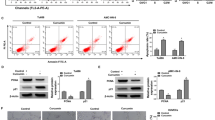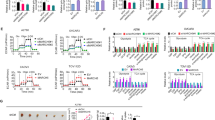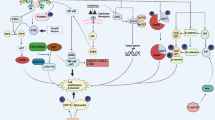Abstract
Pokemon, which stands for POK erythroid myeloid ontogenic factor, can regulate expression of many genes and plays an important role in tumorigenesis. Curcumin, a natural and non-toxic yellow compound, has capacity for antioxidant, free radical scavenger, anti-inflammatory properties. Recent studies shows it is a potential inhibitor of cell proliferation in a variety of tumour cells. To investigate whether curcumin can regulate the expression of Pokemon, a series of experiments were carried out. Transient transfection experiments demonstrated that curcumin could decrease the activity of the Pokemon promoter. Western blot analysis suggested that curcumin could significantly decrease the expression of the Pokemon. Overexpression of Sp1 could enhance the activity of the Pokemon promoter, whereas knockdown of Sp1 could decrease its activity. More important, we also found that curcumin could decrease the expression of the Pokemon by suppressing the stimulation of the Sp1 protein. Therefore, curcumin is a potential reagent for tumour therapy which may target Pokemon.





Similar content being viewed by others
Abbreviations
- Sp1:
-
Specificity protein 1
- ChIP:
-
Chromatin immunoprecipitation assay
- GAPDH:
-
Glyceraldehydes-3-phsphate dehydrogenase
References
Satoskar RR, Shah SJ, Shenoy SG (1986) Evaluation of anti-inflammatory property of curcumin (diferuloyl methane) in patients with postoperative inflammation. Int J Clin Pharmacol Ther Toxicol 24:651–654
Joe B, Vijaykuma M, Lokesh BR (2004) Biological properties of curcumin-cellular and molecular mechanisms of action. Crit Rev Food Sci Nutr 44:97–111
Moragoda L, Jaszewski R, Majumdar AP (2001) Curcumin induced modulation of cell cycle and apoptosis in gastric and colon cancer cells. Anticancer Res 21:873–878
Deeb D, Jiang H, Gao X, Al-Holou S et al (2004) Curcumin sensitizes prostate cancer cells to tumor necrosis factor-related apoptosis-in-inducing ligand/Apo2L by inhibiting nuclear factor-kappaB through suppression of IkappaBalpha phosphorylation. Mol Cancer Ther 3:803–812
Karunagaran D, Rashmi R, Kumar TR (2005) Induction of apoptosis by curcumin and its implications for cancer therapy. Curr Cancer Drug Targets 5:117–129
Pessler F, Pendergrast PS, Hernandez N (1997) Purification and characterization of FBI-1, a cellular factor that binds to the human immunodeficiency virus type 1 inducer of short transcripts. Mol Cell Biol 17:3786–3798
Morrison DJ, Pendergrast PS, Stavropoulos P et al (1999) FBI-1, a factor that binds to the HIV-1 inducer of short transcripts (IST), is a POZ domain protein. Nucleic Acids Res 7:1251–1262
Pendergrast PS, Wang C, Hernandez N et al (2002) FBI-1 can stimulate HIV-1 Tat activity and is targeted to a novel subnuclear domain that includes the Tat-P-TEFb-containing nuclear speckles. Mol Biol Cell 13:915–929
Laudes M, Christodoulides C, Sewter C et al (2004) Role of the POZ zinc finger transcription factor FBI-1 in human and murine adipogenesis. J Biol Chem 279:11711–11718
Widom RL, Lee JY, Joseph C et al (2001) The hcKrox gene family regulates multiple extracellular matrix genes. Matrix Biol 20:451–462
Liu CJ, Prazak L, Fajardo et al (2004) Leukemia/lymphoma-related factor, a POZ domain-containing transcriptional repressor, interacts with histone deacetylase-1 and inhibits cartilage oligomeric matrix protein gene expression and chondrogenesis. J Biol Chem 279:47081–47091
Pessler F, Hernandez N (2003) Flexible DNA binding of the BTB/POZ domain protein FBI-1. J Biol Chem 278:29327–29335
Maeda T, Hobbs RM, Merghoub T et al (2005) Role of the proto-oncogene Pokemon in cellular transformation and ARF repression. Nature 433:278–285
Maeda T, Hobbs RM, Pandolfi PP (2005) The transcription factor Pokemon: a new key player in cancer pathogenesis. Cancer Res 65:8575–8578
Gidoni D, Dynan WS, Tjian R (1984) Multiple specific contacts between a mammalian transcription factor and its cognate promoters. Nature 312:409–413
Suske G (1999) The Sp-family of transcription factors. Gene 238:291–300
Matys V, Kel-Margoulis OV, Fricke E et al (2006) TRANSFAC® and its module TRANSCompel®: transcriptional gene regulation in eukaryotes. Nucleic Acids Res 34(1):D108–D110
Choi WI, Jeon BN, Yun CO et al (2009) Proto-oncogene FBI-1 represses transcription of P21CIP1 by inhibition of transcription activation by p53 and Sp1. J Biol Chem 284:11711–11718
Hanif R, Qiao L, Shiff SJ, Rigas B (1997) Curcumin, a natural plant phenolic food additive, inhibits cell proliferation and induces cell cycle changes in colon adenocarcinoma cell lines by a prostaglandin-independent pathway. J Lab Clin Med 130:576–584
Chen H, Zhang ZS, Zhang YL et al (1999) Curcumin inhibits cell proliferation by interfering with the cell cycle and inducing apoptosis in colon carcinoma cells. Anticancer Res 19:3675–3680
Chen YR, Tan TH (1998) Inhibition of the c-Jun N-terminal kinase (JNK) signaling pathway by curcumin. Oncogene 17:173–178
Leu TH, Maa MC (2002) The molecular mechanisms for the anti-tumorigenic effect of curcumin. Curr Med Chem Anticancer Agents 2:357–370
Lin JK, Pan MH, Lin-Shiau SY (2000) Recent studies on the biofunctions and biotransformations of curcumin. Biofactors 13:153–158
Aggarwal BB, Kumar A, Bharti AC (2003) Anticancer potential of curcumin: preclinical and clinical studies. Anticancer Res 23:363–398
Chadalapala G, Jutooru I, Chintharlapalli S et al (2008) Curcumin decreases specificity protein expression in bladder cancer cell. Cancer Res 68:5345–5354
Thayyullathil F, Chathoth S, Hago A et al (2008) Rapid reactive oxygen species (ROS) generation induced by curcumin leads to caspase-dependent and -independent apoptosis in L929 cells. Free Radic Biol Med 45:1403–1412
Webster KA, Prentice H, Bishopric NH (2001) Oxidation of zinc finger transcription factors: physiological consequences. Antioxid Redox Signal 3:535–548
Author information
Authors and Affiliations
Corresponding author
Rights and permissions
About this article
Cite this article
Cui, J., Meng, X., Gao, X. et al. Curcumin decreases the expression of Pokemon by suppressing the binding activity of the Sp1 protein in human lung cancer cells. Mol Biol Rep 37, 1627–1632 (2010). https://doi.org/10.1007/s11033-009-9575-6
Received:
Accepted:
Published:
Issue Date:
DOI: https://doi.org/10.1007/s11033-009-9575-6




